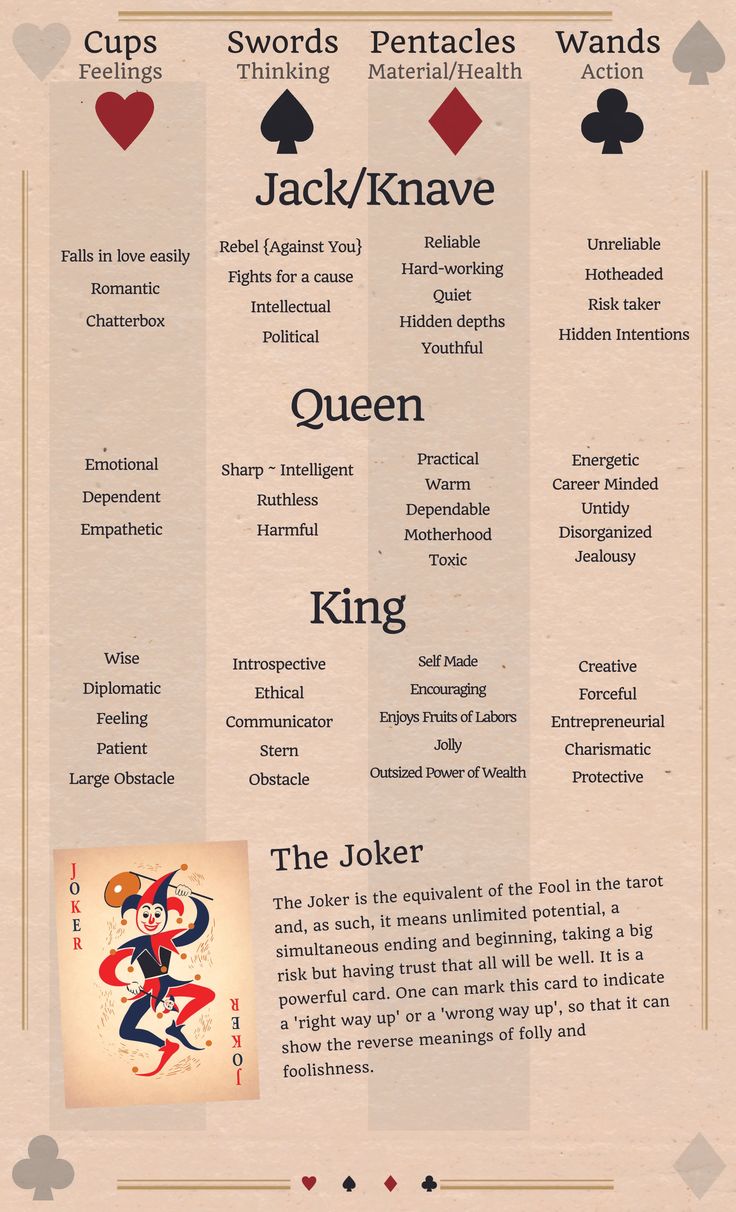The fusion of traditional Tarot with playing cards is a captivating venture that opens up a realm of divinatory possibilities. For those intrigued by the mystical art of tarot reading, understanding the significance of playing cards can enhance both the practice and the depth of interpretation in readings. This article explores the myriad meanings of playing cards in a tarot context, illuminating their symbolic resonance and the methodologies entwined in both divination forms.
Playing cards, comprised of four suits—hearts, diamonds, clubs, and spades—each carry specific attributes that parallel the archetypal symbols found in Tarot. This structural similarity allows practitioners to draw astute comparisons, culminating in a richer comprehension of the esoteric narratives involved.
1. The Suits: An Analogous Paradigm
In Tarot, the suits are divided into wands, cups, swords, and pentacles. Similarly, the suits of playing cards can be analogously mapped. Hearts, for example, align with cups, embodying emotion, relationships, and intuition. Diamonds can be equated to pentacles, symbolizing material wealth and practical matters. Clubs resonate with wands, infusing the energy of action and creativity, while spades parallel swords, often relating to conflict, challenges, and intellect.
2. Numerical Significance
The numerical values on playing cards also bear an intrinsic significance that echoes tarot card meanings. Aces signify new beginnings, akin to the Fool in Tarot—representing potential and the dawn of a journey. Numbered cards from two to ten each carry thematic implications; for instance, the three of hearts (or cups) reflects celebration and community, while the five of spades (or swords) typically denotes conflict and strife.
Face cards in the realm of playing cards serve as court figures in Tarot, representing personalities and archetypes. The King, Queen, and Jack (or Knight) can symbolize authority, nurturing energy, and youthful ambition, respectively. Recognizing these correlations allows a reader to narrate a tale that unveils the querent’s narrative more vividly.
3. The Art of Interpretation
When it comes to employing playing cards in a tarot reading, the methodology remains paramount. A reader’s interpretation hinges on the context of the query presented. The interplay between various cards, their placement, and their synergy can delineate a complex portrait of the querent’s circumstances.
For example, drawing a combination of the two of hearts and the three of diamonds might suggest the blossoming of a relationship that leads to significant financial implications. Conversely, if the seven of spades appears alongside the Queen of clubs, a narrative of betrayal or strife involving a charismatic individual may manifest.
Moreover, the positioning of cards plays an essential role. Utilizing a spread—a designated layout of cards—can influence interpretive nuances. A three-card spread may provide insight into the past, present, and future, while a Celtic cross spread offers a holistic view that embeds the querent’s challenges within a broader context.
4. Symbolism in Context
Delving deeper into the symbolism encapsulated within both Tarot and playing cards reveals an intricate web of meaning. The fusion of mythology, numerology, and psychology contributes to a multifaceted interpretive lens. Each card resonates with different energies: the Ace of Diamonds could evoke aspirations for prosperity, while the seven of hearts might articulate feelings of nostalgia or longing.
Utilizing these symbols effectively demands a keen intuition and a grasp of their significance within the wider tableau of the cards. The role of the reader is not merely to draw and interpret; it is to weave a narrative that is both personal to the querent and reflective of universal truths.
5. Practical Application
In practice, employing playing cards in tarot readings can be refreshing and enlightening. For novices, they often serve as an approachable gateway into the world of divination. The simplicity of playing cards can demystify initial forecasts, allowing budding readers to hone their intuition without the often-overwhelming imagery associated with traditional Tarot.
However, seasoned tarot practitioners may find the incorporation of playing cards reinvigorating. It provides a unique lens through which familiar meanings can be revisited, offering new interpretations and insights that may have been previously overlooked.
One engaging method of blending these two forms involves the creation of a personalized deck, wherein one might adapt traditional tarot imagery with the familiar parameters of playing cards. This transforms the act of reading into a deeply personal practice, aligning the symbols with the individual reader’s experiences and insights.
6. The Conclusion: A Harmonious Union
Ultimately, the interplay between playing cards and Tarot reveals a tapestry of meaning rife with potential for exploration and insight. Both systems, while distinct, converge upon essential archetypes and principles that illuminate the human experience. By understanding and harnessing the meanings projected by playing cards within a Tarot reading framework, practitioners can enrich their interpretations, offering profound clarity and guidance to those who seek it.
In the hands of an adept reader, this synergy transforms readings into multifaceted explorations, bridging the conventional with the esoteric and elevating the art of divination to new heights.









Leave a Comment